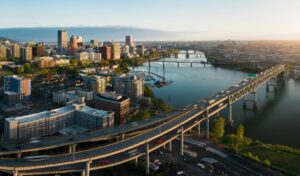Portland Urban Growth Boundary plays a crucial role in maintaining the city’s unique balance between urban development and environmental preservation. One of the many draws to living in Portland is how quickly you can escape the urban area and find yourself surrounded by lush forests, rolling farmland, and open green spaces. Unlike many metropolitan regions that continuously expand outward, Oregon took a proactive approach by implementing an urban growth boundary law. This law controls the Portland area’s urban expansion, ensuring that farmland, forests, and natural landscapes remain protected. Thanks to this regulation, newcomers relocating to Portland can enjoy the best of both worlds—city conveniences with easy access to nature.
Portland Urban Growth Boundary
For those moving to Portland, understanding the impact of the Portland urban growth boundary is essential. By limiting unchecked sprawl, the law has preserved Oregon’s natural beauty while encouraging responsible urban planning. As a result, Portland remains one of the most sustainable cities in the U.S., with thoughtfully designed neighborhoods, walkable communities, and efficient public transportation. Whether you’re looking for a home in the city or a quieter place on the outskirts, the Portland Urban Growth Boundary shapes where development occurs and ensures a high quality of life for residents.
Planning for the Future
To keep up with housing demand while preserving farmland and forests around Portland, urban infill has become a key strategy. Infill development makes use of underutilized spaces within already built-up areas, allowing for new construction without expanding the city’s footprint. This includes repurposing abandoned lots, converting commercial spaces into residential properties, and increasing housing density in certain districts. For newcomers relocating to Portland, this means a mix of modern apartments, townhomes, and revitalized neighborhoods that maintain the city’s character while accommodating growth.
The Portland Urban Growth Boundary is not a static limit—it is reviewed every twenty years to account for population changes and economic shifts. To manage future expansion responsibly, urban and rural reserves were established. These reserves designate land outside the current boundary for either long-term conservation or future urban development. By planning decades in advance, Portland ensures that growth occurs in a controlled and sustainable manner. This methodical approach makes the city an attractive destination for those moving to Portland who value both urban amenities and environmental stewardship.
The Living Smart Program: A Sustainable Solution
Portland has long been a leader in urban sustainability, and its approach to infill development has evolved over time. In 1991, zoning changes encouraged redevelopment of existing land, leading to an increase in subdivided lots and tract housing. While this provided much-needed housing, the results were often visually unappealing to residents. In response, the city launched the Living Smart program in 2003 to refine infill development.
The Living Smart program limited new construction to vacant lots and introduced design guidelines to ensure aesthetic harmony within neighborhoods. Additionally, an international design competition was held to create innovative, space-efficient housing solutions. The winning designs not only influenced Portland’s future developments but also became models for sustainable urban growth worldwide. This progressive approach showcases Portland’s dedication to responsible planning, making it an appealing choice for newcomers relocating to Portland.
Smart Growth and Urban Density
With Portland’s continued growth, density is an ongoing focus. Currently, the city has a population density of approximately 4,375 people per square mile. However, thanks to thoughtful urban planning, Portland has maintained its European-inspired charm, pedestrian-friendly streets, and well-connected public transit system. The Portland Urban Growth Boundary ensures that new developments contribute to a vibrant, livable city rather than sprawling suburbs.
For those moving to Portland, the benefits of controlled growth are evident in the city’s efficient layout, strong sense of community, and accessibility to green spaces. Whether you prefer an urban lifestyle in the heart of the city or a quieter suburban neighborhood, the Portland Urban Growth Boundary helps maintain a balance that supports sustainable growth and high-quality living.
Request your free Portland Relocation Guide here




